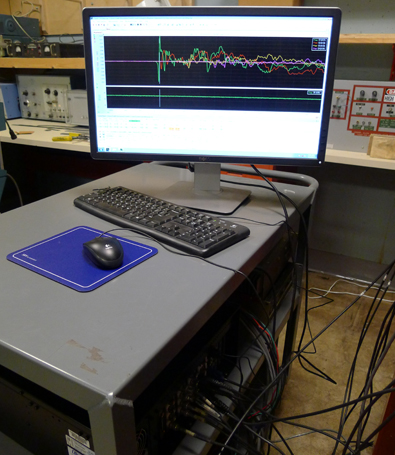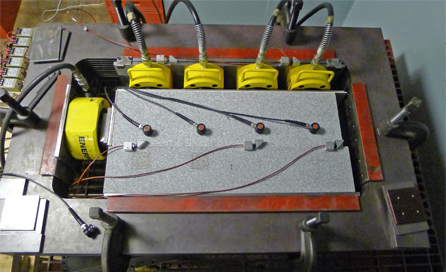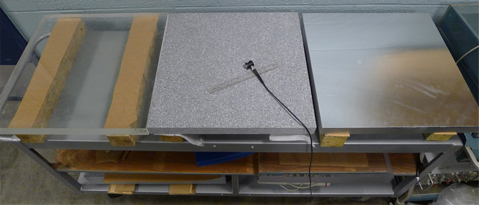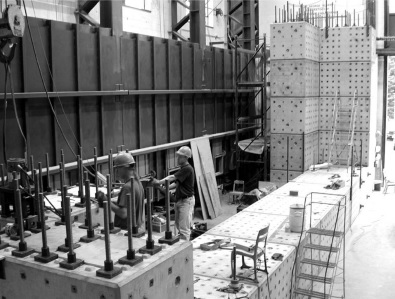3 m Biaxial Apparatus

Laboratory earthquake experiments are conducted on a 3 m biaxial rock squeezing machine that consists of a steel load frame that is 3 meters wide and 4.9 m long and hydraulic cylinders capable of applying 32 MN of force to a 3-meter-long slab of Barre gray granite. This apparatus is located in the George Winter high bay of the Bovay laboratory complex (see below) because it requires the use of the overhead crane to lift the 4000 lb samples.
This apparatus is used to study the mechanics of fault rupture and the physical mechanisms by which faults and fractures generate seismic waves. This machine is the largest of its kind in the world, and it is four times larger than a tabletop apparatus also built in the McLaskey lab (shown below). Comparison between results from the two machines will facilitate scaling studies so that the laboratory results can be scaled up to natural earthquakes.
The 3D model shown below can be used to view the design in more detail. The each one of the yellow hydraulic cylinders is capable of applying 100 tons of force (890 kN). The two granite blocks typically rest on wooden supports, but during an experiment those supports are lowered so that the granite is supported by friction side without any constrains on the top or bottom. Construction of this machine took place primarily in the summer of 2016. More details on the construction can be found here

Sensors and Data Recording
Our lab includes a high speed data aquisition system that can record at ten million samples per second (10 MHz). We also have a variety of piezoelectric vibration sensors that can detect sub-nanometer-amplitude vibrations in solid materials such as metals, rocks, and plastics. We have non-contact eddy current displacement sensors that are good to very low frequencies and can detect sub-micron displacements. We also have access to a number of other sensors that are housed in the Bovay Lab Complex (see below) including accelerometers, LVDTs, and strain sensors.
Analysis Techniques
We use a variety of tools to better understand mechanical systems and digital signals. These include including finite element analysis software such as ABAQUS, ANSYS, and PYLITH. Most of our signal analysis codes are written in house using MATLAB. These include source location codes and full waveform forward modeling sofware that are designed for the analysis and interpretation of very small amplitude time series signals.
Tabletop Biaxial Apparatus
 The apparatus shown in the left can squeeze a 0.76 m-long rock sample (gray) with up to 2 MN (450,000 lbs) of force! These high forces are enough for pressure on the simulated fault to reach 25 MPa. This simulates the pressure that is exerted on rocks deep below the
surface of the Earth where earthquakes initiate. The pressures are increased by means of the hydraulic jacks (yellow). The sample and jacks all sit inside a loading frame that is cut from solid
sheets of steel. When the laboratory fault slips, tiny earthquakes are detected with an array of piezoelectric sensors (black and red circles) and local fault slip is measured at a number of
locations with eddy current slip sensors (silver). This machine is used to create and analyze laboratory-generated earthquakes. Results from this apparatus relating to slow slip and earthquake
nucleation processes were published in Journal of Geophysical Research here
The apparatus shown in the left can squeeze a 0.76 m-long rock sample (gray) with up to 2 MN (450,000 lbs) of force! These high forces are enough for pressure on the simulated fault to reach 25 MPa. This simulates the pressure that is exerted on rocks deep below the
surface of the Earth where earthquakes initiate. The pressures are increased by means of the hydraulic jacks (yellow). The sample and jacks all sit inside a loading frame that is cut from solid
sheets of steel. When the laboratory fault slips, tiny earthquakes are detected with an array of piezoelectric sensors (black and red circles) and local fault slip is measured at a number of
locations with eddy current slip sensors (silver). This machine is used to create and analyze laboratory-generated earthquakes. Results from this apparatus relating to slow slip and earthquake
nucleation processes were published in Journal of Geophysical Research here
A 3D model of the apparatus with transparent plastic samples is shown below.
Test Plates for Calibration

The lab also includes large test plates of various materials (plastic, granite, and aluminum shown on the right) that are ideal for calibration studies. Waves propagate in solid materials similar to the way ripples propagate on the surface of a pond (there are some key differences, of course). But waves in solids are typically too small in amplitude and too high in frequency for us to feel or see. The plates allow us to make sure that our models of wave propagation and sensor response are accurate.

Bovay Laboratory Complex
The McLaskey research laboratory is located within a large laboratory complex called the Bovay Laboratory Complex. This shared facility includes a the George Winter High Bay (right) serviced by a 10-ton crane, a low bay with electronic and materials testing and fabriction facilities, and an electronic classroom.